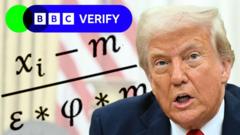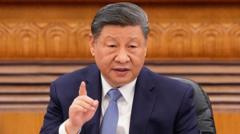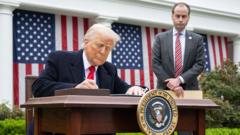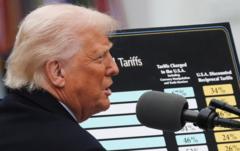President Trump's recent announcement of sweeping tariffs on various countries has begun to redefine international economic relationships, alienating key allies while igniting concerns about a new wave of protectionism.**
Growing Tensions: Trump's Tariffs Amplify Global Trade Disputes**

Growing Tensions: Trump's Tariffs Amplify Global Trade Disputes**
U.S. Tariff Plan Widens Rift with Allies Amidst Escalating Trade War**
April 2, 2025, 5:41 p.m. ET – In a decisive move that has sent shockwaves through global markets and diplomatic relations, President Trump has unveiled an extensive tariff plan targeting numerous countries worldwide. This strategy aims to assert U.S. interests in international trade but has ignited significant tension between the United States and some of its longstanding allies.
The newly announced tariffs, branded as a "reciprocal" response, impose a staggering 20 percent levy on the European Union and a sharp 34 percent on China, among other nations. Eswar Prasad, an economist at Cornell University, remarked, "The breadth and magnitude of these tariffs instill fears that we are entering an era of heightened protectionism likely to resonate throughout the global economic landscape."
Interestingly, neighbors Mexico and Canada appear to dodge major impacts from this latest tariff wave, as they remain exempt from these new charges beyond existing levies linked to the U.S.-Mexico-Canada Agreement. All other nations face a foundational 10 percent tariff, alongside additional stipulations based on their own import taxes or barriers against U.S. exports.
This bold tariff initiative marks a significant escalation in the U.S.-led trade war, following previous measures targeting steel, aluminum, and automotive imports. Though Trump has made threats to impose high tariffs on Canadian and Mexican goods, these have not yet materialized, while different levy approaches have been piloted against China.
As nations brace themselves for the fallout from this trade strategy, the ripple effects promise to challenge traditional alliances and provoke a revaluation of trade dynamics on a global scale.
The newly announced tariffs, branded as a "reciprocal" response, impose a staggering 20 percent levy on the European Union and a sharp 34 percent on China, among other nations. Eswar Prasad, an economist at Cornell University, remarked, "The breadth and magnitude of these tariffs instill fears that we are entering an era of heightened protectionism likely to resonate throughout the global economic landscape."
Interestingly, neighbors Mexico and Canada appear to dodge major impacts from this latest tariff wave, as they remain exempt from these new charges beyond existing levies linked to the U.S.-Mexico-Canada Agreement. All other nations face a foundational 10 percent tariff, alongside additional stipulations based on their own import taxes or barriers against U.S. exports.
This bold tariff initiative marks a significant escalation in the U.S.-led trade war, following previous measures targeting steel, aluminum, and automotive imports. Though Trump has made threats to impose high tariffs on Canadian and Mexican goods, these have not yet materialized, while different levy approaches have been piloted against China.
As nations brace themselves for the fallout from this trade strategy, the ripple effects promise to challenge traditional alliances and provoke a revaluation of trade dynamics on a global scale.






















